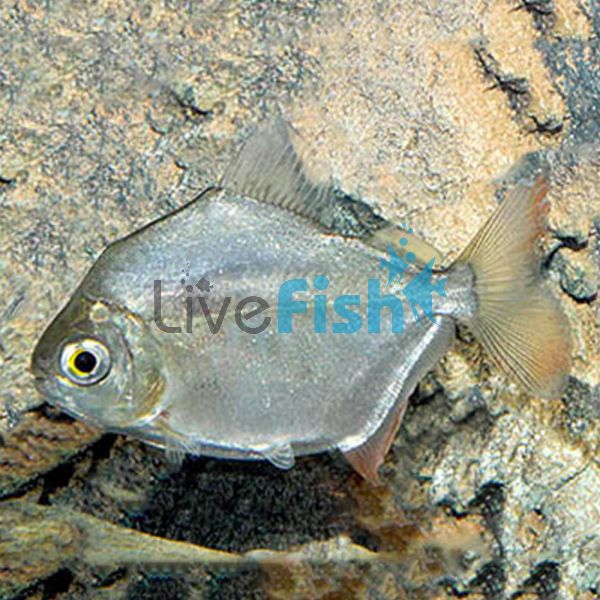Silver Dollar 5cm
The Silver Dollar would have to be one of the world's most popular larger schooling fish, their size, activity, and metallic colouration make them a perfect consideration for large aquariums needing life. What tends to be a surprise is that these fish are actually tetras and a very close, near-vegetarian cousin to the piranha. There are also a few different species of these fish available in the aquarium hobby but the common silver dollar is most popular. They are amazing fish to add to a larger cichlid aquarium or even a South American biotope.
- Buy 4 for $18.79 each and save 10%
- Buy 8 for $16.70 each and save 20%
Silver Dollar
The Silver Dollar would have to be one of the world's most popular larger schooling fish, their size, activity, and metallic colouration make them a perfect consideration for large aquariums needing life. What tends to be a surprise is that these fish are actually tetras and a very close, near-vegetarian cousin to the piranha. There are also a few different species of these fish available in the aquarium hobby but the common silver dollar is most popular. They are amazing fish to add to a larger cichlid aquarium or even a South American biotope.
Silver Dollars as their name suggests have a round, dollar-like body shape. These are fish that get fairly large reaching a maximum length of almost 20 cm and their height alone can be 15 cm. This round body is covered in a metallic skin with shades of silver, blue, yellow, and jade green which all reflect light amazingly. Silver dollars also have an array of tiny scales that look like stars that also just shimmer under led lighting. As these silver dollars mature, they actually can develop a piranha-like red belly which is especially vibrant when these fish get into breeding behaviour. Aside from their colours, silver dollars also have comically large eyes for their face and their mouth is quite small with a limited opening range but when you have a very close look at their teeth, it looks surprisingly human-like.
Breeding silver dollars is possibly in captivity however it is not incredibly common in the home aquarium. These fish need a large spawning tank and there isn’t much of a re-sale incentive considering how cheap these fish are in a retail setting. They breed like any other tetra and tend to scatter eggs in dense plant material or a spawning mop. The male will fertilize the eggs however the parents do not show any protection for the fry.
Tank Recommendations for your Silver Dollar
As the silver dollar has a large footprint and prefers to be kept in schools of at least 5 fish or more, it is best to keep it in an aquarium with a minimum volume of 400 liters. This ensures that they have ample swimming space since these are active fish. Silver dollars can be extremely skittish fish at times so it is always best to keep them in a system with minimal obstructions.
The actual aquascape of the tank is not of major concern but a soft, sandy substrate with river stones and short pieces of driftwood will do fine for them. These fish are also massive herbivores and will essentially eat any plant they are kept with. Silver dollars are also tropical fish that are best kept at 24-26 degrees.
Suitable Tank Buddies
The silver dollar is a fairly peaceful species, due to their herbivorous nature, they can generally be kept with fish of all sizes however it is best to avoid fish smaller than their mouth.
Usually Compatible
Oscar, congo tetras, corydoras, plecos, angelfish, clown loaches, and a range of other peaceful to even semi-aggressive species.
Sometimes Compatible
Keeping silver dollars with any extremely territorial cichlids may pose long-term issues with species such as jaguar cichlids constantly attacking the silver dollars.
Rarely Compatible
Any nano fish like neon tetras, endlers guppies, shrimp, and large predator fish such as barramundi or dovii which could make a meal of the silver dollar
Feeding your Silver Dollar
The silver dollar is a fish that will take to a wide range of foods however their diet should be treated much like a lake Malawi African cichlid. These fish are omnivorous however they will really prefer to feed on plant material-based foods. Feeding them a herbivorous pellet supplemented with some frozen foods and even fruit like bananas is a great diet for them.
| Scientific Name | Metynnis Spp. |
|---|---|
| Care Level | Easy |
| Common Names | Silver Dollar, Common Silver Dollar |
| Diet | Omnivore |
| Fish Family | Characidae |
| Lifespan (years) | 10 |
| Max. Length (cm) | 20 |
| Min. Tank Volume (l) | 400 |
| Origin | South America |
| Reef Safe | Yes |
| Sociability | Peaceful |
| Venomous | No |
| Water Conditions | 24-26° C, pH 6.0-7.0 |




